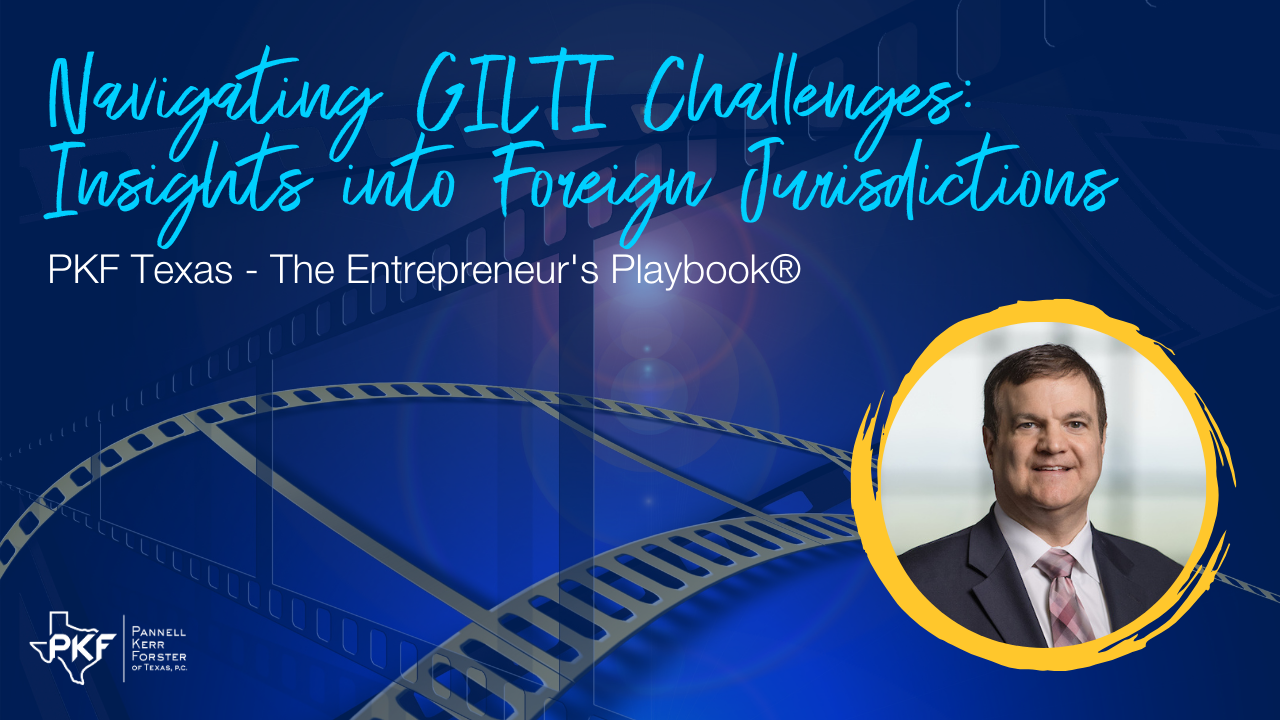Navigating GILTI Challenges: Insights into Foreign Jurisdictions

In this episode, Jen and Frank dissect the complexities of dealing with foreign-controlled corporations in different jurisdictions. Learn about the GILTI high tax exception and understand why statutory rates aren’t the only consideration. Dive into the computation using US tax principles and explore the potential complications.
Jen: This is the PKF – Texas the Entrepreneur’s Playbook, I’m Jen Lemanski, and I’m back once again with Frank Landreneau one of the Approachable Advisors® and a leader of our international tax practice. Frank, welcome back to the Playbook.
Frank: Thank for having me again.
Jen: So, we talked about GILTI last time. Now I know there may be some things for like individuals with pass serenities that may have foreign controlled corporations. What should they be on the lookout for? What do they need to know?
Frank: There’s some structural changes but there’s also some annual elections that companies can make. So, one of these annual elections is the GILTI high tax exception. So, the concept is, is if you’re paying a rate of tax in the foreign jurisdiction that is close to the US rate specifically 90% of the corporate rate, which comes out to be 18.9%, then you can exclude that income from GILTI. And what ends up happening, if you meet that test, you can defer that income and then if you ever bring it back in the form of a dividend, then you can pay tax on it at that time. And typically, if you’re dealing with a treaty country, you’re paying a much lower rate, like to the tune of 20% plus the 3.8% net investment income tax rate. That’s really one of the things to look at.
Now one of the complications a lot of people think about, well, if I’m dealing with an OECD country, let’s say a Western European country, their rates are a little bit higher or close to the US’s. Well, you don’t look at the statutory rate. You actually have to do a computation of what the tax base would be using US tax principles and apply the foreign tax that you pay using foreign tax principles and see what the rate is. So, it’s a little bit more complicated than that. There are some downsides to it because once you make the election, you make the election for all of your controlled foreign corporations. So, you could have an unusual situation where because of their timing mismatches because you’re dealing with two different foreign jurisdictions like the US jurisdiction versus the non-US jurisdiction. You could actually have a loss in the US if you compute your income based in US principles and still pay tax in the foreign jurisdiction. Which you could still pay a high rate of tax under that scenario. Well, you’d have to exclude the loss from the computation because GILTI is a shareholder computation where you net income and losses of the different entities. You would also be excluding some of the losses too. So modeling is key before you make this decision to make this election.
Jen: Yeah. You want to know what all the ins and outs and what have yous are going to be.
Frank: Absolutely.
Jen: I know last time you mentioned something about Section 962. Is there anything that folks need to know about that?
Frank: Yeah, that’s an election that’s been around for a long time, since the 1960s, but it’s been brought back because for the longest time we had a rate of tax that was pretty close between the corporate rate and the individual rates. So right now, the corporate rate, the highest rate’s 21%, the individual rate, the highest rate’s 37%. We haven’t seen that big of a range of taxation since the 1960s. So that kind of brought this old election back. And what you can do is basically on an annual basis, elect to be treated for this purpose only to be treated to be taxed as a corporation. And then in doing so, you’re taxed at that much lower rate that 10.5% rate that I talked about earlier, that corporations could be taxed on and GILTI.
Jen: So that’s yet another factor for the modeling potentially.
Frank: Exactly. And see how that kind of works. Yeah. Now, the 962 election does have its downside. So, normally when you pick up GILTI income, when you bring back the income in the form of a distribution, you’re not taxed on it again. But if you make the 962 election and elect to be treated like a corporation, when you bring back the income, let’s say you make a distribution to the extent you didn’t pay tax on this income, but previously, you are subject to a residual tax. But in many cases, what we’ve found, if you’re dealing with a treaty jurisdiction like Western European Economy or some of our major trading partners like Canada or Mexico. You could actually end up at a much lower rate than in the absence of not making the election. So once again, modeling is key.
Jen: Definitely something to consider. And yeah, get those models and see what ultimately works best for your business.
Frank: And we can help in that regard and doing the different scenarios for you.
Jen: Perfect. Well, we’ll get you back to talk a little bit more about that. Sound good?
Frank: Sounds great. Thank you.
Jen: This has been another Thought Leader production, brought to you by PKF – Texas the Entrepreneur’s Playbook. For more information about this and other topics, visit pkftexas.com/insights. Tune in next week for another chapter.

